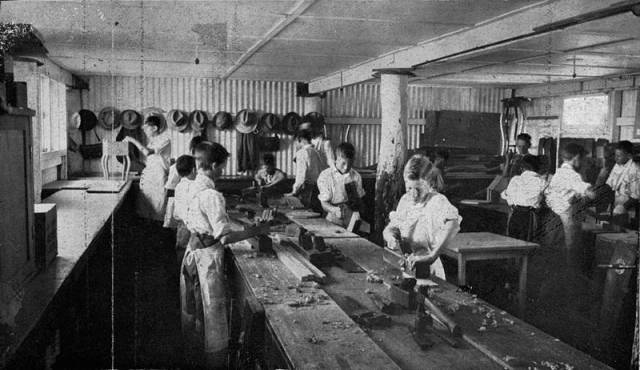
MsDebbieP
in over 11 years
History: Woodworking Classes
I found these two photos online… very interesting.
The first is from 1933 and the second is 1901

http://commons.wikimedia.org/wiki/File:StateLibQld_1_195779_Woodworking_class_at_Stanthorpe_State_School,_1933.jpg
JAGO - just a grandma’s opinion
9 Replies
These workshops look a lot neater than today’s high school workshops!
Anna
Debbie,
Isn’t it wonderful the way they taught young boys to be productive. It’s too bad we don’t still do that!
L/W
“Those who would give up essential Liberty, to purchase a little temporary Safety, deserve neither Liberty nor Safety.” Benjamin Franklin
We should bring that back…
Abbas, Castro Valley, CA
We do still have woodworking classes for boys and girls in our primary and youth (jr. high?) schools here in Norway. The problem is that the teachers really don’t know much about woodworking as they no longer have dedicated ‘shop’ teachers.
Just some thoughts about the real importance of woodworking shop classes for youth. Woodworking classes were first devised (in Sweden as far as I know) not to teach woodworking per se. The real and very conscious purpose was to teach exactness, the rewards of good work, the importance of maintaining tools and keeping an orderly shop, safe working practices, and the pride that comes with a job well done. It seems that woodworking being both a physical and mental exercise has the most influence on behavior and the molding of character than just book learning or doing tasks with no obvious product (like cleaning up your bedroom for example). These were all valuable learning points and particularly relevant at the time since most of those boys would eventually be working in jobs with their hands and probably with hand tools. The learning experience could only have been reinforced by the fact that woodworking is also a lot of fun and that their class project became a wonderful Christmas gift for their mother which she would cherish for the rest of her life.
In my view, woodworking classes for our kids remains an effective way to build character to this day and schools should continue to place an emphasis on this part of a youngster’s education and we don’t need a vast array of expensive machines to do it with either, just capable teachers and shop classes with sufficient hand tools.
PS I thought it was fun to see all those hats hanging in the background of the first photo.
Mike, an American living in Norway
Mike hits the nail (sorry). The manual training created by Otto Solomon was called Sloyd, or Slojd. Sloyd eventually became Manual Arts Education, which in turn became Vocational Education. Solomon wrote a number of books, the most popular was a book for Sloyd teachers: The Teacher’s Hand-Book Of Slojd, published in 1891. Sloyd was first taught in the US at what is now the North Bennett Street School in Boston.
Gary Roberts, woodworking, old books and old tools
I think we are seeing a new revolution starting to take shape with the advent of CNC routing machines etc. I have seen shop-bots used in several Middle and HS shops in recent months. One of the biggest hurdles is learning the coding necessary to run the machines. Between wood and metal shops, where a CNC plasma cutter is used I think we are going to see a resurgence of shop skills.
Once a week when I was in junior high we’d have shops class, ranging from cooking and sewing to welding and woodworking. I still have a small metal piston on my keychain that I made in grade 9. As an educational experience, it was mostly a failure; I didn’t retain any of the skills I learnt (although a particularly gruesome safety video instilled a healthy respect for the planer) however as a life experience it was important. I don’t remember how to weld or use a metal lathe, and the woodworking shop didn’t really influence my decision to pick up woodworking as a hobby but the time in those classes provided me with some good memories and a vague appreciation of those skills (as well as a scar on my right index finger from cutting it on metal and needing stitches…) I hope today’s hyper-safety culture doesn’t phase out shops classes or even worse, instil fear rather than appreciation and respect for these skills.
Rob, Sault Ste. Marie, Ontario
I read an article today about how schools were starting to focus “computing Science” classes (programming) as general “problem solving” training. They expect it will give students a skill at thinking problems through.
I suppose in that light putting CNC machines in the shops will aid in that end, allowing students to use the skills in practical ways. I still think that traditional methods are also a good tool for developing problem solving, but times change and so does the workplace.
Also, programming a CNC is probably safer for a 14 year old than handing them a chisel and a mallet :)
-- Alec (Friends call me Wolf, no idea why)
True, throughout history mankind has had to learn to use new tools as they were invented and CNC machines are just a new addition. My only reservation about this is that there is a certain satisfaction to be had from working with your hands. I am not against CNC or laser engraving machines as an addition to our arsenal of tools, but I do hope that they will not entirely replace hand tools as there is something special about handwork that is beyond the abilities of a machine. A good example of that is that design changes are often made during and ongoing project as ideas occur to the craftsman or artist. A computerized process cannot do that.
Mike, an American living in Norway
















